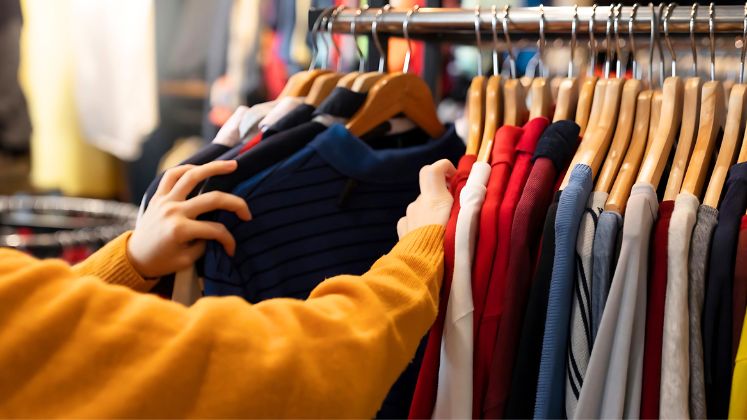Every apparel brand needs a clear sourcing strategy. The choice between local and global sourcing involves factors like cost-effectiveness, supply chain evaluation, quality assurance and market demand analysis.
Local sourcing offers immediate cost savings by reducing transportation expenses and tariffs and mitigating currency fluctuation risks. It also ensures shorter supply chains, leading to lower inventory costs and increased flexibility in response to market demands.
Local sourcing is particularly advantageous where quality control, customisation and quick turnaround times are critical. It allows easier access for frequent quality inspections and immediate issue resolution. For instance, many fashion houses like Benetton have started sourcing closer to home. In 2022, Benetton boosted its manufacturing in Europe, West Asia and North Africa, moving production out of Bangladesh and Vietnam. Similarly, a study showed that Swedish textile and apparel buyers plan to increase sourcing in Europe while reducing or altering sourcing in Asia.
For Indian apparel brands, local sourcing can provide significant cost savings compared to international sourcing. By sourcing locally, brands can avoid import duties of up to 40 per cent on apparel products, leading to around 20 per cent savings on production costs.
I agree that it’s not possible for all the brands to source 100 per cent locally. Therefore when considering global sourcing, Indian brands must weigh in multiple factors. For example, China offers competitive pricing and fast turnaround times but faces rising labour costs and trade tensions. Bangladesh has the lowest labour costs but struggles with quality consistency and longer lead times. Vietnam provides a balance with competitive labour costs, high-quality production, flexible minimum order quantities and improving logistics. Nevertheless, it’s essential to adopt a nuanced approach.
| ‘Local sourcing can cut production costs by 20 per cent’
Sidhant Keshwani, Founder and CEO, Libas Libas is an omnichannel brand that sells fast fashion Indian traditional apparel for women across both offline and online channels. The brand claims to cross Rs. 500 crore revenue mark in FY ’24. |
For example, a fashion brand based in India might find the most cost-effective supplier of elastics in Vietnam. However, to fully capitalise on cost savings, the supplier might opt for cheaper transportation such as barges, leading to extended delivery times unless expedited shipping is paid for. In such a scenario, the brand might choose the Vietnamese supplier for regular orders but devise a contingency plan for urgent projects, possibly maintaining a stockpile of materials. Alternatively, the brand might opt for slightly pricier elastics from another supplier. Each brand must evaluate its priorities and decide whether cost or speed takes precedence in sourcing materials. This decision-making process is unique to each entity, regardless of size and different companies will have distinct sets of requirements.
Today’s consumers value sustainability, ethical production and supply chain transparency. This drives us to source 100 per cent of our raw materials domestically. This strategy helps Libas in the long term by ensuring that all sourcing and manufacturing processes are streamlined within the country, leading to better control over quality and consistency of materials.
For brands considering global expansion, local sourcing offers a distinct advantage. In today’s global economy, knowing the origins of our raw materials is just the starting point. We must also ensure that our materials are responsibly sourced, a requirement enforced by regulators and expected by consumers. This requires thorough due diligence on every material and accessory we use.
Many countries are now enforcing traceability laws. India too is expected to introduce comparable legislation in the foreseeable future, aligning with global trends toward responsible sourcing and production practices. This raises important questions: Were the cotton and other materials ethically harvested? Were fair labour conditions maintained during fabric production? If we cannot provide satisfactory answers to regulatory inquiries and consumer concerns about sourcing transparency, our ability to market products in regions with tightening legislation may be compromised.
Local sourcing is not just about efficiency but also about investing in the future of the Indian garment industry. By relying on local suppliers, businesses strengthen the domestic economy. According to a FICCI-Wazir Advisors report, the Indian textile and apparel market was valued at approximately US $ 165 billion in 2022, with the domestic market accounting for US $ 125 billion and exports contributing US $ 40 billion. With a positive long-term outlook, the market size is projected to grow at a compound annual growth rate (CAGR) of 10 per cent, reaching US $ 350 billion by 2030. This translates to significant employment opportunities, fostering economic growth and improving livelihoods within local communities.
| ‘India has its limitations’
Navin S Rao, Co-founder, The Kaftan Company The Kaftan Company, founded in 2016 by Prakruti Gupta Rao and Navin Rao, provides a wide range of loungewear and kaftans. Available on major e-commerce platforms, the company has seen 5x growth in the past two years. |
Today’s consumers value sustainability, ethical production and supply chain transparency. This drives us to source 100 per cent of our raw materials domestically. This strategy helps Libas in the long term by ensuring that all sourcing and manufacturing processes are streamlined within the country, leading to better control over quality and consistency of materials.
At Kaftan, we occasionally encounter unique fabric prints or specific elasticities that aren’t easily found locally. In such cases, we examine the production process of these fabrics and consider, ‘This could enhance the comfort for our customers, so let’s experiment’. From a developmental angle, we assess these unique materials retrospectively. If, post-production, they match our style and quality standards, we move forward with sourcing them. For instance, in our previous summer collection, we procured some fabrics from China. We discovered that the elasticity and comfort of that fabric would delight our consumers.
However, since the start, we’ve prioritised local sourcing, mainly for its cost-effectiveness. Initially, procuring large quantities of fabric was impractical. Moreover, dealing with import duties and logistics would’ve strained our resources.
Also, developing the supply chain and building relationships with vendors in a new country takes time. Each stage needs to be evaluated properly to avoid risks. Initially, one major hurdle is the small order sizes of some brands. With only a handful of stores, we lack substantial order volumes and foreign manufacturers are often unwilling to accommodate small orders. In contrast, Indian manufacturers offer flexibility in minimum order quantities, allowing us to order anywhere from 500 to 50,000 pieces, catering to our specific needs.
Moreover, India has a massive market for sourcing. For example, states like Gujarat can produce lakhs of metres of fabric with numerous options available. India also has over a thousand GOTS (Global Organic Textile Standard)-certified factories and many other certified units dedicated to ethical and sustainable production, providing flexible production options. Raw materials from India also tend to offer more stable pricing, with less variation.
That’s why, even international brands are increasing their sourcing from India. For example, France-based menswear brand Celio plans to increase its sourcing from India by five times from 4 per cent at present to 20 per cent over the coming two years. Global lifestyle brands such as Patagonia are utilising regenerative organic cotton fields in India. Moreover, major fashion retailers such as Zara, Gap, Levi’s, Mango, Marks & Spencer and Tommy Hilfiger have also established manufacturing operations in India.
Though, no brand can commit to local sourcing indefinitely. It all boils down to how the market evolves and the relevance of the available fabrics. Also, it’s true that India has its limitations. While we excel in cotton and natural fabrics, our infrastructure, investment and R&D in high-quality MMF (Man-Made Fibres) are lacking. This often leads us to rely on imports from China for these materials. Bangladesh and Vietnam are often preferred for finished products due to their advanced infrastructure.
Specific yarns such as Bi-shrinkage yarns are also not readily available locally and are imported from China. This poses a challenge, particularly for brands in womenswear, as they often struggle with local sourcing and resort to importing of high-end yarns.
However, for brands specialising in menswear such as denim, India and Bangladesh provide ample options and opportunities for sourcing materials.











